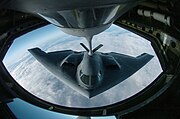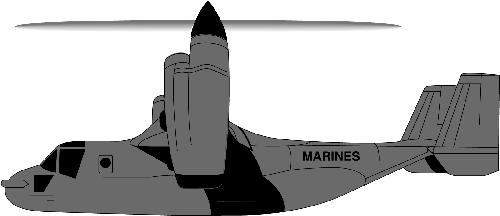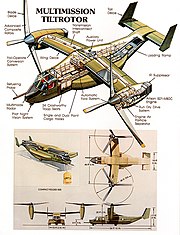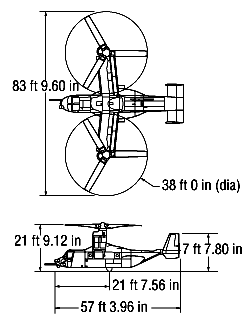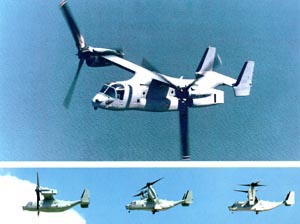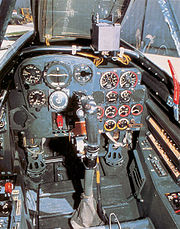
The
Messerschmitt Me 262 Schwalbe (
German for
Swallow) was the world's first operational
turbojet fighter aircraft. It was produced in
World War II and saw action starting in 1944 as a multi-role fighter/bomber/reconnaissance/interceptor warplane for the
Luftwaffe. German pilots nicknamed it the
Sturmvogel (Stormbird), while the
Allies called it the Turbo. The Me 262 had a negligible impact on the course of the war due to its late introduction, with 509 claimed Allied kills (although higher claims are sometimes made) against the loss of more than 100 Me 262s.
Specifications (Messerschmitt Me 262 A-1a)
Data from Quest for Performance Original Messerschmitt documents
General characteristics
- Crew: One
- Length: 10.60 m (34 ft 9 in)
- Wingspan: 12.60 m (41 ft 6 in)
- Height: 3.50 m (11 ft 6 in)
- Wing area: 21.7 m² (234 ft²)
- Empty weight: 4,404 kg (9,709 lb)
- Loaded weight: 7,130 kg (15,720 lb)
- Max takeoff weight: 6977 kg (15,381 lb)
- Powerplant: 2× Junkers Jumo 004B-1 turbojets, 8.8 kN (1,980 lbf) each
- Aspect ratio: 7.23
Performance
Armament
- Guns: 4x 30 mm MK 108 cannons (A-2a: two cannons)
- Rockets: 24x 55 mm (2.2 in) R4M rockets
- Bombs: 2x 250 kg (550 lb) bombs (A-2a only)
Design and development
The Me 262 was already being developed as Projekt P.1065 before the start of World War II. Plans were first drawn up in April 1939, and the original design was very similar to the plane that eventually entered service. The progression of the original design into service was delayed greatly by technical issues involving the new jet engines. Funding for the jet program was also initially lacking, as many high-ranking officials thought the war could easily be won with conventional aircraft. Adolf Hitler had envisioned the Me 262 not as a defensive interceptor, but as an offensive ground attack/bomber, almost as a very high speed, light payload Schnellbomber. His edict resulted in the development of the Sturmvogel (Stormbird) variant. It is debatable to what extent Hitler's interference extended the delay in bringing the Swallow into operation.
The aircraft was originally designed with a tail wheel undercarriage and the first four prototypes (Me 262 V1-V4) were built with this configuration, but it was discovered on an early test run that the engines and wings "blanked" the stabilizers, giving almost no control on the ground, as well as serious runway surface damage from the hot jet exhaust. Changing to a tricycle undercarriage arrangement, initially a fixed undercarriage on the "V5" fifth prototype, then fully retractable on the sixth (V6, with code VI+AA) and succeeding aircraft, corrected this problem.
Although it is often stated the Me 262 is a "swept wing" design, the production Me 262 had a leading edge sweep of only 18.5°. This was done primarily to properly position the center of lift relative to the centre of mass and not for the aerodynamic benefit of increasing the critical Mach number of the wing. The sweep was too slight to achieve any significant advantage. This happened after the initial design of the aircraft, when the engines proved to be heavier than originally expected. On 1 March 1940, instead of moving the wing forward on its mount, the outer wing was positioned slightly backwards to the same end. The middle section of the wing remained unswept.. Based on data from the AVA Göttingen and windtunnel results, the middle section was later swept.
The first test flights began on 18 April 1941, with the Me 262 V1 example, bearing its Stammkennzeichen radio code letters of PC+UA, but since its intended BMW 003 turbojets were not ready for fitting, a conventional Junkers Jumo 210 engine was mounted in the V1 prototype's nose, driving a propeller, to test the Me 262 V1 airframe. When the BMW 003 engines were finally installed, the Jumo was retained for safety, which proved wise as both 003s failed during the first flight and the pilot had to land using the nose mounted engine alone.

Messerschmitt Me 262 Schwalbe, the world's first jet fighter.
The V3 third prototype airframe, with the code PC+UC, became a true "jet" when it flew on 18 July 1942 in Leipheim near Günzburg, Germany, piloted by Fritz Wendel. This was almost nine months ahead of the British Gloster Meteor's first flight on 5 March 1943. The 003 engines, which were proving unreliable, were replaced by the newly available Junkers Jumo 004. Test flights continued over the next year, but the engines continued to be unreliable. Airframe modifications were complete by 1942, but hampered by the lack of engines, serial production did not begin until 1944. This delay in engine availability was in part due to the shortage of strategic materials, especially metals and alloys able to handle the extreme temperatures produced by the jet engine. Even when the engines were completed, they had an expected operational lifetime of approximately 50 hours; in fact, most 004s lasted just 12 hours. A pilot familiar with the Me 262 and its engines could expect approximately 20 to 25 hours of life from the 004s. Changing a 004 engine was intended to require three hours, but typically took eight to nine due to poorly made parts and inadequate training of ground crews.
Turbojet engines have less thrust at low speed than propellers and as a result, low-speed acceleration is relatively poor. It was more noticeable for the Me 262 as early jet engines (before the invention of afterburners) responded slowly to throttle changes. The introduction of a primitive autothrottle late in the war only helped slightly. Conversely, the higher power of jet engines at higher speeds meant the Me 262 enjoyed a much higher climb speed. Used tactically, this gave the jet fighter an even greater speed advantage in climb rate than level flight at top speed.
With one engine out, the Me 262 still flew well, with speeds of 450 to 500 km/h (280 to 310 mph), but pilots were warned never to fly slower than 300 km/h (186 mph) on one engine, as the asymmetrical thrust would cause serious problems.
Operationally, the Me 262 had an endurance of 60 to 90 minutes.
Operational history
In April 1944, Erprobungskommando 262 was formed at Lechfeld in Bavaria as a test unit (Jaeger Erprobungskommando Thierfelder) to introduce the 262 into service and train a core of pilots to fly it. On 26 July 1944, Lt. Alfred Schreiber with the 262 A-1a W.Nr. 130 017 downed a Mosquito reconnaissance aircraft. It was the first victory for a turbojet fighter aircraft in aviation history. Major Walter Nowotny was assigned as commander after the death of Werner Thierfelder in July 1944, and the unit redesignated Kommando Nowotny. Essentially a trials and development unit, it holds the distinction of having mounted the world's first jet fighter operations. Trials continued slowly, with initial operational missions against the Allies in August 1944 allegedly downing 19 Allied aircraft for six Me 262s lost, although these claims have never been verified by cross-checking with USAAF records. The RAF Museum holds no intelligence reports of RAF aircraft engaging in combat with Me 262s in August, although there is a report of an unarmed encounter between an Me 262 and a Mosquito. Despite orders to stay grounded, Nowotny chose to fly a mission against an enemy formation. After an engine failure, he was shot down and killed on 8 November 1944 by 1st Lt Edward “Buddy” Haydon of the 357th Fighter Group, USAAF and Capt Ernest “Feeb” Fiebelkorn of the 20th Fighter Group, USAAF. The "Kommando" was then withdrawn for further training and a revision of combat tactics to optimise the 262's strengths.
By January 1945, Jagdgeschwader 7 (JG 7) had been formed as a pure jet fighter unit, although it would be several weeks before it was operational. In the meantime, a bomber unit—I Gruppe, Kampfgeschwader 54 (KG 54)—had re-equipped with the Me 262 A-2a fighter-bomber for use in a ground attack role. However, the unit lost 12 jets in action in two weeks for minimal returns.
Jagdverband 44 (JV 44) was another Me 262 fighter unit formed in February, by Lieutenant General Adolf Galland, who had recently been dismissed as Inspector of Fighters. Galland was able to draw into the unit many of the most experienced and decorated Luftwaffe fighter pilots from other units grounded by lack of fuel.
During March, Me 262 fighter units were able, for the first time, to mount large scale attacks on Allied bomber formations. On 18 March 1945, 37 Me 262s of JG 7 intercepted a force of 1,221 bombers and 632 escorting fighters. They shot down 12 bombers and one fighter for the loss of three Me 262s. Although a four-to-one ratio was exactly what the Luftwaffe would have needed to make an impact on the war, the absolute scale of their success was minor, as it represented only one per cent of the attacking force. In 1943 and early 1944, the USAAF had been able to keep up offensive operations despite loss ratios of 5% and more, and the few available Me 262s could not inflict sufficient losses to hamper their operations.

Side view of a Me 262 night fighter, note the
radar antenna on the nose and second seat for a radar operator.
Several two-seat trainer variants of the Me 262, the Me 262 B-1a, had been adapted as night fighters, complete with on-board FuG 218 Neptun radar and "stag's antlers" (Hirschgeweih) antenna, as the B-1a/U1 version. Serving with 10 Staffel, Nachtjagdgeschwader 11, Night Fighter wing, near Berlin, these few aircraft (alongside several single seat examples) accounted for most of the 13 Mosquitoes lost over Berlin in the first three months of 1945. However, actual intercepts were generally or entirely made using Wilde Sau methods, rather than AI radar-controlled interception. As the two-seat trainer was largely unavailable, many pilots had to make their first flight in a jet in a single seater without an instructor.
Despite its deficiencies, the Me 262 clearly signaled the beginning of the end of piston-engined aircraft as effective fighting machines. Once airborne, it could accelerate to speeds well over 800 km/h (500 mph), over 150 km/h (93 mph) faster than any Allied fighter operational in the European Theater of Operations.
The Me 262's top ace was probably Hauptmann Franz Schall with 17 kills which included six four-engine bombers and ten P-51 Mustang fighters, although night fighter ace Oberleutnant Kurt Welter claimed 25 Mosquitos and two four-engined bombers shot down by night and two further Mosquitos by day flying the Me 262. Most of Welter's claimed night kills were achieved in standard radar-less aircraft, even though Welter had tested a prototype Me 262 fitted with Neptun radar. Another candidate for top ace on the aircraft was Heinrich Bär, who claimed 16 enemy aircraft while flying the Me 262.
Anti-bomber tactics
The standard approach against bomber formations, which were travelling at cruise speed, called for the Me 262 to approach the bombers from the rear at a higher altitude, diving in below the bomber's flight level to get additional speed before gaining altitude again and, on reaching the bomber's level, opening fire with its four 30 mm cannon at 600 m (656 yard) range.
Allied bomber gunners found that their electric gun turrets had problems tracking the jets. Target acquisition was difficult because the jets closed into firing range quickly and had to remain in firing position only briefly using their standard attack profile.
Eventually, new combat tactics were developed to counter the Allied bombers' defences. Me 262s equipped with R4M rockets would approach from the side of a bomber formation, where their silhouettes were widest, and while still out of range of the .50 caliber guns, fire a salvo of these explosive rockets. The explosive power of only one or two of these rockets was capable of downing even the famously rugged B-17- a strike on an enemy aircraft meant its total annihilation. Although this tactic was effective, it came too late to have a real effect on the war. This method of attacking bombers became the standard until the invention and mass deployment of guided missiles. Some nicknamed this tactic the "Luftwaffe's Wolf Pack", as the fighters would often make runs in groups of two or three, fire their rockets, then return to base.
On 1 September 1944, USAAF General Carl Spaatz expressed the fear that if greater numbers of German jets appeared, they could inflict losses heavy enough to force cancellation of the Allied daylight bombing offensive.
Counter-jet tactics
Tactics against the Me 262 developed quickly despite its great speed advantage. Allied bomber escort fighters would fly high above the bombers — diving from this height gave them extra speed, thus reducing the speed difference. The Me 262 was less maneuverable than the P-51 and trained Allied pilots could catch up to a turning Me 262, though the only reliable way of dealing with the jets, as with the even faster Komet rocket fighters, was to attack them on the ground and during take off and landing. Luftwaffe airfields that were identified as jet bases were frequently bombed by medium bombers, and Allied fighters patrolled over the fields to attack jets trying to land. The Luftwaffe countered by installing flak alleys along the approach lines in order to protect the Me 262s from the ground and providing top cover with conventional fighters during takeoff and landing. Nevertheless, in March and April 1945, Allied fighter patrol patterns over Me 262 airfields resulted in numerous losses of jets and serious attrition of the force.
Another experimental tactic was installing nitrous oxide injection, much like the Germans' own GM-1 system, into Mustangs. When chasing an Me 262, the pilot could press a button injecting nitrous oxide into the engine, producing a quick burst of speed.
Other Allied fighters that encountered the Me 262 included the British Supermarine Spitfire, Hawker Tempest and the Soviet Lavochkin La-7. The first recorded Allied destruction of a Me 262, belonging to the unit known as Kommando Schenk, was on 28 August 1944, claimed as destroyed by 78th FG pilots Major Joseph Myers and 2nd Lt. Manford O. Croy flying P-47s. Oberfeldwebel Hieronymus "Ronny" Lauer of I KG(J) 51, on a landing pattern crash landed his 262 to get away from the Allied fighters, which then destroyed the Me 262 in strafing attacks. The first Me 262 shot down in combat, belonging to 3. Staffel/Kampfgeschwader 51, with unit code letters "9K+BL", was on 5 October 1944, by Spitfire IXs of 401 RCAF. The 262 pilot was H.C. Butmann in WNr 170093 of 3./KG51. The Lavochkin was the only Soviet fighter to shoot down a German jet, with La-7 ace Ivan Nikitovich Kozhedub, downing an Me 262 on 15 February 1945 over eastern Germany.
High speed research
Willy Messerschmitt regarded the Me 262 as only an interim type when it went into production.
Swept wings had been proposed as early as 1935 by Adolf Busemann, and Messerschmitt had researched the topic from 1940. In April 1941, he proposed fitting a 35° swept wing (Pfeilflügel II, literally arrow wing II) to the Me 262, the same wing sweep angle that would later be used on both the American F-86 Sabre and Soviet MiG-15 fighter jets. Though this was not implemented, he continued with the projected HG II and HG III (Hochgeschwindigkeit, high speed) derivatives in 1944, which were designed with a 35° and 45° wing sweep, respectively.
Interest in high-speed flight, which led him to initiate work on swept wings starting in 1940, is evident from the advanced developments Messerschmitt had on his drawing board in 1944. While the Me 262 HG I actually flight tested in 1944 had only small changes compared to combat aircraft, most notably a low-profile canopy (tried as the Rennkabine (literally racing cabin) on the Me 262 V9 prototype for a short time) to reduce drag, the HG II and HG III designs were far more radical. The projected HG II combined the low-drag canopy with a 35° wing sweep and a butterfly tail. The HG III had a conventional tail, but a 45° wing sweep and turbines embedded in the wingroot.
Messerschmitt also conducted a series of flight tests with the series production Me 262. In dive tests, it was determined that the Me 262 went out of control in a dive at Mach 0.86, and that higher Mach numbers would lead to a nose-down trim that could not be countered by the pilot. The resulting steepening of the dive would lead to even higher speeds and disintegration of the airframe due to excessive negative g loads.
The HG series of Me 262 derivatives was estimated to be capable of reaching transonic Mach numbers in level flight, with the top speed of the HG III being projected as Mach 0.96 at 6 km altitude. Despite the necessity to gain experience in high-speed flight for the HG II and III designs, Messerschmitt undertook no attempts to exceed the Mach 0.86 limit for the Me 262.
After the war, the Royal Aircraft Establishment, at that time one of the leading institutions in high-speed research, re-tested the Me 262 to help with British attempts at exceeding Mach 1. The RAE achieved speeds of up to Mach 0.84 and confirmed the results from the Messerschmitt dive tests. Similar tests were run by the Soviets. No attempts were made to exceed the Mach limit established by Messerschmitt.
After Willy Messerschmitt's death, the former Me 262 pilot Hans Guido Mutke claimed to be the first person to exceed Mach 1, on 9 April 1945 in a Me 262 in a "straight-down" 90° dive. This claim is disputed because it is only based on Mutke's memory of the incident, which recalls effects other Me 262 pilots observed below the speed of sound at high indicated airspeed, but with no altitude reading required to determine the actual speed. Furthermore, the pitot tube used to measure airspeed in aircraft can give falsely elevated readings as the pressure builds up inside the tube at high speeds. Finally, the Me 262 wing had only a slight sweep incorporated for trim (center of gravity) reasons and likely would have suffered structural failure due to divergence at high transonic speeds. One airframe (Me 262 HG1 V9 WNr130 004 VI+AD ) was prepared with the low-profile Rennkabine racing canopy and may have achieved an unofficial record speed of 606 mph, altitude unspecified.
Postwar history and flyable reproductions
After the end of the war, the Me 262 and other advanced German technologies were quickly swept up by the Americans (as part of the USAAF's Operation Lusty), British, and Soviets. Many Me 262s were found in readily-repairable condition and were confiscated.
The Me 262 was found during testing to have advantages over the early models of the Gloster Meteor. It was faster, had better cockpit visibility to the sides and rear (mostly due to the canopy frame and the discoloration caused by the plastics used in the Meteor's construction), and was a superior gun platform, as the early Meteors had a tendency to snake at high speed and exhibited "weak" aileron response. The Me 262 did have a shorter combat range than the Meteor.
The USAAF compared the P-80 Shooting Star and Me 262 concluding, "Despite a difference in gross weight of nearly 2,000 lb (907 kg), the Me 262 was superior to the P-80 in acceleration, speed and approximately the same in climb performance. The Me 262 apparently has a higher critical Mach number, from a drag standpoint, than any current Army Air Force fighter." The Army Air Force also tested an example of the Me 262A-1a/U3 (US flight evaluation serial FE-4012), an unarmed photoreconnaissance version, which was fitted with a fighter nose and given an overall smooth finish. It was used for performance comparisons against the P-80. During testing between May and August 1946, the aircraft completed eight flights, lasting four hours and 40 minutes. Testing was discontinued after four engine changes were required during the course of the tests, culminating in two single-engine landings.
These aircraft were extensively studied, aiding development of early U.S. and Soviet jet fighters. The F-86 Sabre, designed by the engineer Edgar Schmued, used the Me 262 airfoil (Messerschmitt Wing A) and a slat design similar to that of the Me 262.
The Czechoslovak aircraft industry continued to produce single-seater (designated Avia S-92) and two-seater (designated Avia CS-92) variants of the Me 262 after World War II. From August 1946, a total of nine single-seater S-92 and three two-seater CS-92 planes were completed and test flown. They were introduced in 1947 and in 1950 they were supplied to the 5th Fighter Squadron. These were kept flying as late as 1957. They were the first jet fighters to serve in the Czechoslovak Air Force. Both versions are on display at the Prague Aero museum in Kbely.
In January 2003, the American Me 262 Project completed flight testing to allow for delivery of near-exact reproductions of several versions of the Me 262 including at least two B-1c two-seater variants, one A-1c single seater and two "convertibles" that could be switched between the A-1c and B-1c configurations. All are powered by General Electric J85 engines and feature additional safety features, such as upgraded brakes and strengthened landing gear. The "c" suffix refers to the new J-85 powerplant and has been informally assigned with the approval of the Messerschmitt Foundation in Germany. Flight testing of the first newly manufactured Me 262 A-1c (single seat) variant was completed in August 2005. The first of these machines went to a private owner in the southwestern United States, while the second was delivered to the Messerschmitt Foundation at Manching, Germany. This aircraft conducted a private test flight in late April 2006, and made its public debut in May at the Berlin Air Show (ILA 2006). The new Me 262 flew during the public flight demonstrations. Me 262 Werk Number 501241 was delivered to the Collings Foundation as White 1 of JG 7. This aircraft will be offering ride-along flights starting in 2008
source : Wikipedia








 ,
,



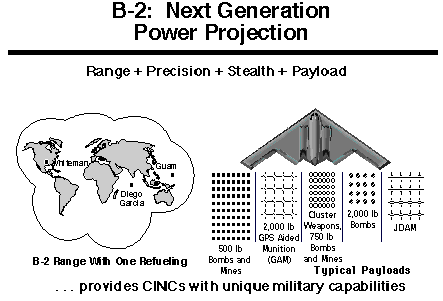
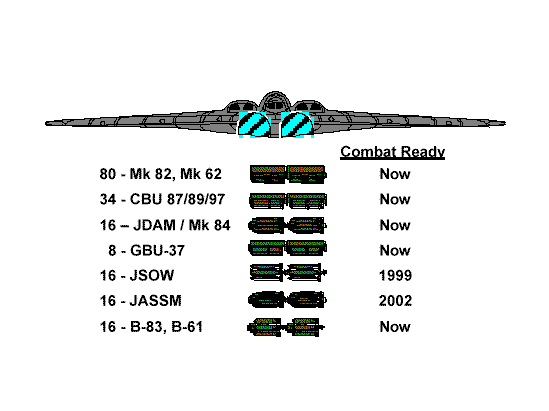
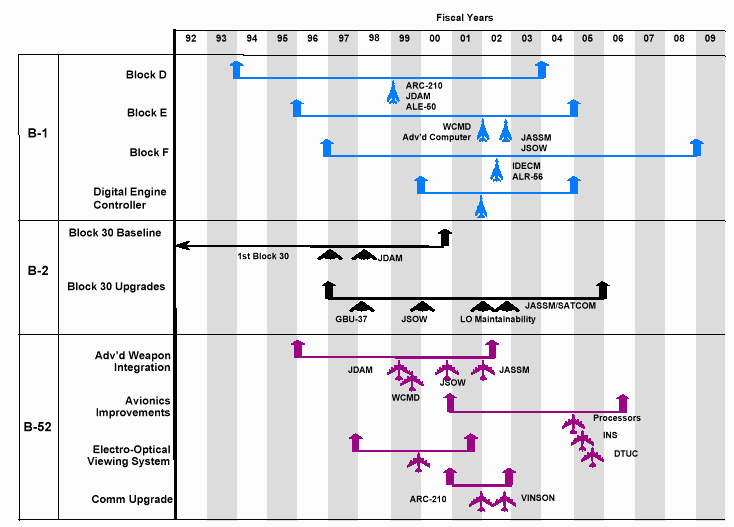
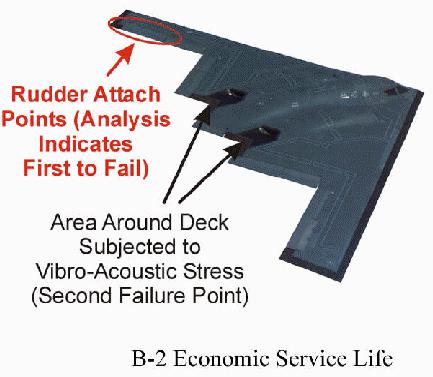 The basis for the useful life of the B-2 includes data from initial Developmental Test and Evaluation analysis. Data indicates the aircraft should be structurally sound to approximately 40,000 flight hours using current mission profiles. Analysis further suggests that the rudder attachment points are the first structural failure item. The B-2 has not implemented an ASIP similar to the other bombers, and this makes it difficult to predict the economic service life and attrition rate. However, a notional projection, based on the B-52, predicts one aircraft will be lost each 10 years. This attrition rate, plus attrition due to service life, will erode the B-2 force below its requirement of 19 aircraft by 2027.
The basis for the useful life of the B-2 includes data from initial Developmental Test and Evaluation analysis. Data indicates the aircraft should be structurally sound to approximately 40,000 flight hours using current mission profiles. Analysis further suggests that the rudder attachment points are the first structural failure item. The B-2 has not implemented an ASIP similar to the other bombers, and this makes it difficult to predict the economic service life and attrition rate. However, a notional projection, based on the B-52, predicts one aircraft will be lost each 10 years. This attrition rate, plus attrition due to service life, will erode the B-2 force below its requirement of 19 aircraft by 2027. 
